 |
|
I Ching & The Human Body
Class Two: The Hexagram
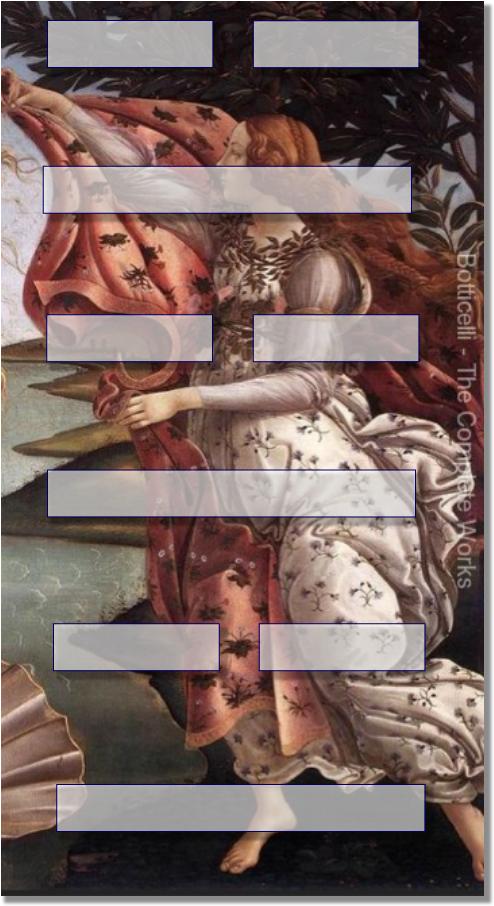
The Birth of Venus (detail), C 1485. Sandro Botticelli
 Class Two: The Hexagram Please study this page with Audio Lecture Two.
Class Two: The Hexagram Please study this page with Audio Lecture Two.
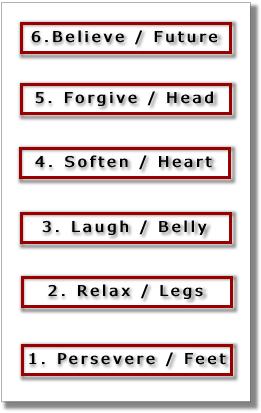 I. The Hexagram as Body: In order to best convey the primordial or archetypal nature of the I Ching, we'll begin by seeing the hexagrams in their most somatic possible expression, i.e., as a symbolic model of the human body. What we see here are the six lines (always counted from the bottom up) with their corresponding region of the body. The first term we encounter for each line is the "circuit breaker" - i.e, the quality to enact or embody in order to be in ones gift or power (traditionally called "superior") rather than shadow or wound (or "inferior"). For example, the first line, connected with the feet, represents the beginning of any situation or "moment" of time. The challenge we face is insecurity, which we habitually avoid (enact shadow or wound) either through impulse or hesitation. The "circuit breaker" or quality that will ground us, literally keep our feet connected to the ground, is simply recognizing that the beginning of any new experience or challenge requires steady, grounded perseverance.
I. The Hexagram as Body: In order to best convey the primordial or archetypal nature of the I Ching, we'll begin by seeing the hexagrams in their most somatic possible expression, i.e., as a symbolic model of the human body. What we see here are the six lines (always counted from the bottom up) with their corresponding region of the body. The first term we encounter for each line is the "circuit breaker" - i.e, the quality to enact or embody in order to be in ones gift or power (traditionally called "superior") rather than shadow or wound (or "inferior"). For example, the first line, connected with the feet, represents the beginning of any situation or "moment" of time. The challenge we face is insecurity, which we habitually avoid (enact shadow or wound) either through impulse or hesitation. The "circuit breaker" or quality that will ground us, literally keep our feet connected to the ground, is simply recognizing that the beginning of any new experience or challenge requires steady, grounded perseverance.
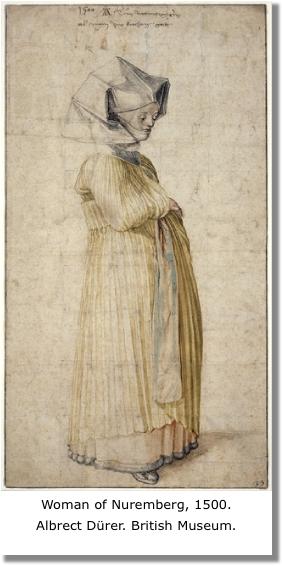 II. The Hexagram as Two Inner and Outer Trigrams: In Class One we looked at the trigrams that make up the hexagram. The lower trigram (lines one through three) is called "inner" or "within" and the upper trigram (lines four through six) is called "outer" or "without." Roughly speaking, these are what are conventionally thought of subjective and objective, though these terms aren't entirely apt. The inner trigram refers to the mood or emotional feeling tone that we feel within. The outer refers to the qualities we feel without. It is easy to see that we always have an "inner" mood and a feeling for the world "without." For example, on a given day we might say, "I feel great, but I'm finding today to be somewhat irritating." This could be called, firm within, danger or pitfall without. In this way, we can identify hexagrams "everywhere." In looking at this drawing by Albrect Dürer, what qualities would you ascribe to the woman's inner and outer trigrams?
II. The Hexagram as Two Inner and Outer Trigrams: In Class One we looked at the trigrams that make up the hexagram. The lower trigram (lines one through three) is called "inner" or "within" and the upper trigram (lines four through six) is called "outer" or "without." Roughly speaking, these are what are conventionally thought of subjective and objective, though these terms aren't entirely apt. The inner trigram refers to the mood or emotional feeling tone that we feel within. The outer refers to the qualities we feel without. It is easy to see that we always have an "inner" mood and a feeling for the world "without." For example, on a given day we might say, "I feel great, but I'm finding today to be somewhat irritating." This could be called, firm within, danger or pitfall without. In this way, we can identify hexagrams "everywhere." In looking at this drawing by Albrect Dürer, what qualities would you ascribe to the woman's inner and outer trigrams?
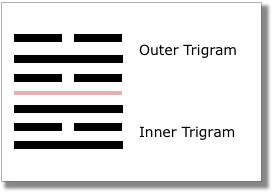
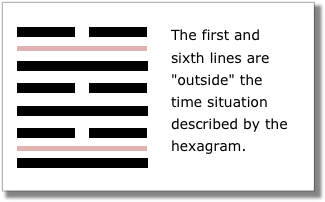 III. The Hexagram as Time. As well as being a somatic symbol of the human body, each hexagram depicts time, or the "time we are in." The hexagrams depicts many dimensions of time - horizontal and vertical, for instance - and studying the I Ching can help us realize the nature of time in all its dimensions (as well as time's non-existence). The first and sixth lines are traditionally considered "outside" the hexagram in that the first is just "entering" and thereby considerably connected to the past, and the sixth or top line is "leaving" or already part of the future, part of the next hexagram. (These lines are not necessarily any less significant in a given hexagram, nor do they always carry these meanings; general principles are subservient to the makeup of each specific hexagram.) All the lines can represent time in various ways, including linear, seasonal or cyclical time, and the "time for" - i.e., when a specific action become possible. Above all, each hexagram represents the "time we are in" as potential for growth and manifestation of our highest calling.
III. The Hexagram as Time. As well as being a somatic symbol of the human body, each hexagram depicts time, or the "time we are in." The hexagrams depicts many dimensions of time - horizontal and vertical, for instance - and studying the I Ching can help us realize the nature of time in all its dimensions (as well as time's non-existence). The first and sixth lines are traditionally considered "outside" the hexagram in that the first is just "entering" and thereby considerably connected to the past, and the sixth or top line is "leaving" or already part of the future, part of the next hexagram. (These lines are not necessarily any less significant in a given hexagram, nor do they always carry these meanings; general principles are subservient to the makeup of each specific hexagram.) All the lines can represent time in various ways, including linear, seasonal or cyclical time, and the "time for" - i.e., when a specific action become possible. Above all, each hexagram represents the "time we are in" as potential for growth and manifestation of our highest calling.
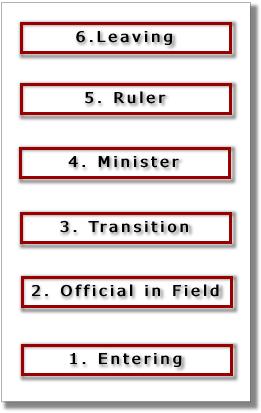 IV. The Hexagram as Group, Society, Organization. This diagram depicts the most traditional and fundamental meaning of the lines - and we will have much to say about this as we go along. The first and sixth lines are somewhat "outside the situation" - as explained above. The second line is ideally an active and devoted agent of the ruler; the third line bears the greatest challenge of the intersection of the inner and outer trigrams; the forth line ideally selflessly supports the rule; the fifth, of couse, is the the ruler, being in the upper trigram and by virtue of being "strong, central and correct" - i.e. strong as in yang, central as being the in center line of the trigram, correct in that the ruling line should be strong (all other things being equal; it all depends on the specific hexagram).
IV. The Hexagram as Group, Society, Organization. This diagram depicts the most traditional and fundamental meaning of the lines - and we will have much to say about this as we go along. The first and sixth lines are somewhat "outside the situation" - as explained above. The second line is ideally an active and devoted agent of the ruler; the third line bears the greatest challenge of the intersection of the inner and outer trigrams; the forth line ideally selflessly supports the rule; the fifth, of couse, is the the ruler, being in the upper trigram and by virtue of being "strong, central and correct" - i.e. strong as in yang, central as being the in center line of the trigram, correct in that the ruling line should be strong (all other things being equal; it all depends on the specific hexagram).
The audio lecture will discuss the three hexagrams below in relationship to these four aspects of the hexagrams.
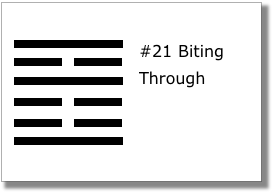
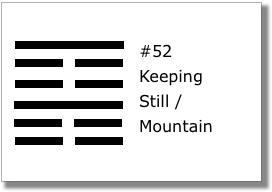
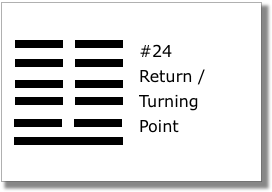

I Ching & The Human Body
An On-line Class with Bill Scheffel
Introduction & To Register
Class One: The Trigrams
Class Two: The Hexagram
Class Three: The Hexagram II
Class Four: Assimilation
Class Five: Early Heaven...
Class Six: Acquired Conditioning..
Class Seven: Standing Under...
See more classes...

INTUITIVE DIALOGUES & I CHING READINGS with Bill Scheffel
The I Ching is a teacher to me, a revered guide, even a "hobby" - something I simply love to study, consult and share with others. I first opened the I Ching in 1970, when still in high school, intrigued and mystified by what it had to say. I began to actively engage with the I Ching in 1990, soon after I met Howard Bad Hand, an indispensable teacher who opened the book for me, removed the mystification and made it practical. in 2001, I began consulting the I Ching every morning, a practice that became a way of life.
I offer I Ching-intuitive readings for people in person, over the phone or through Skype. A reading begins with an initial conversation in which I listen to the issues in your life that form the basis of your question. From there, you "throw the coins" and I study the outcome in preparation for the full reading, typically done the following day. I help bring the symbolic images of the I Ching into the fabric of your question and life. Though the council I provide is founded on my experience with the I Ching, and intuitive guidance - the psychic or intangible dimension of life - it is very much a mutual conversation, a container we create together for insight to occur.
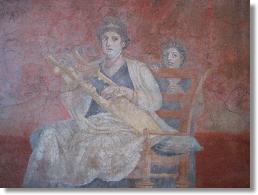
What is the I Ching?
The I Ching is perhaps humanity's oldest book, with roots preceding the Chinese Xia Dynasty of 2200 - 1800 BCE. The I Ching consists of sixty-four hexagrams, symbolic images that mirror the various life-situations we find ourselves in, and offer guidance for making correct decisions.
Traditionally called an oracle, the I Ching is a way of opening our life-questions to a larger system. Jung called this system synchronicity, “the peculiar interdependence” between ourselves and the events around us." This is also the world of the unconscious, of dreams, of contemplation. It is the world of spirit, the world of the dralas. This larger world is potentially always available to us, ready to support our highest aspirations.
The I Ching is way of consulting this larger world, and our own heart, the very center of the crossroads of life decisions. Our heart, as a spiritual force, is "outside of time" - i.e., beyond our usual occupations of hope and fear. In consulting the I Ching we "receive" a given hexagram through a random method - typically tossing coins. In such a method we have no control over the outcome, only the courage to inquire. In this matrix of sincerity and surrender, synchronicity can speak and spirit can enter, voices that can resonate with the truth of our own heart, the ultimate place of guidance.
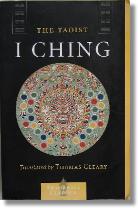
I Ching, the "Book of Change" is considered the oldest of the Chinese classics, and has throughout its history commanded unsurpassed prestige and popularity. It has been considered a book of fundamental principles by philosophers, politicians, mystics, alchemists, yogins, diviners, sorcerers, and more recently, scientists and mathematicians... Continuing interest in the I Ching is enhanced by the fact that it has never been universally regarded as the sole property of any particular religion, cult or school of thought. - Introduction to The Taoist I Ching, translated by Thomas Cleary.